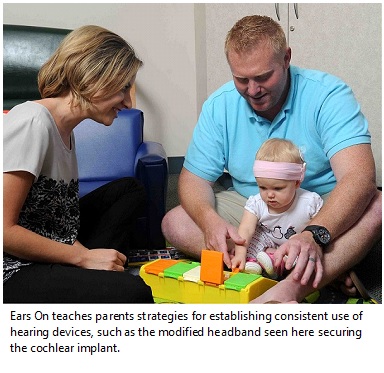Ears On An Evidence-Based Program to Improve Hearing Device Use in Children
Tuesday, November 3, 2020
 For children with hearing loss, hearing devices such as hearing aids and cochlear implants provide access to speech sounds that are critical to their development of spoken language. However, children must regularly wear their devices to receive the full language development benefits [1].
For children with hearing loss, hearing devices such as hearing aids and cochlear implants provide access to speech sounds that are critical to their development of spoken language. However, children must regularly wear their devices to receive the full language development benefits [1].
Ears On is a program developed and evaluated by Sophie Ambrose, Ph.D., Coordinator of the Clinical Measurement Program and her team at Boys Town National Research Hospital. Ears On is designed to help parents ensure regular device use for their children. The program focuses on educating families of the importance of children consistently wearing their hearing devices and provides practical tips to help with compliance of wearing them.
Practical Concerns Affect Hearing Device Use
When it comes to getting children to wear hearing devices, there are some common challenges. We know children take them off without parents' knowledge. Parents may choose not to have kids wear their devices during some activities. Other caregivers may not realize the importance of the devices and may fail to encourage or enforce wearing them. And, families sometimes just forget [2-3].
Some of these factors are made worse by a lack of understanding of the developmental importance of consistent hearing device use. Hearing the sounds of speech and language during critical developmental periods supports brain development that will affect a child's long-term academic, social and professional success.
Ears On Education to Help Families Manage Hearing Device Use
Ears On starts with ensuring parents understand their child's individual hearing loss, including the speech sounds their child will miss without amplification and the impact it can have on language development. The intervention also seeks to show parents how much of a difference they can expect in hearing and language development with regular device use and to empower parents to believe they can establish consistent device use.
To meet these goals, Ears On methods include reviewing the results of the child's previous hearing assessments, using simulations of the child's hearing with and without hearing devices, presenting video examples of the language development of children with hearing losses similar to their child's and discussion of related topics.
Finally, to help parents improve their child's hearing device use, Ears On includes sessions that support parents in identifying and becoming confident in using strategies to address each of the barriers the family faces in establishing consistent device use. For examples, parents may learn strategies to encourage their child not to remove his or her devices or advocacy strategies to use with other caregivers.
Ears On Program Evaluation
Dr. Ambrose and her team tested Ears On with three parent-child pairs, with the three children being from 16 to 33 months old at the time of entry into the study. After Ears On, they found that all three improved in hearing aid compliance, with two them meeting the program goal of eight hours of average daily device use [2]. This study shows early promise for supporting parents and children by offering an intensive intervention focused on hearing device use. One of the keys to the success of the intervention was the individualization based on each family's needs. Additional work by the research team has included developing and validating a measure of parents' perceived beliefs, knowledge, confidence, and actions related to supporting their children's hearing device use and language development. This tool, which is available in
a recent article in the Journal of Early Hearing Detection and Intervention, can help clinicians individualize their efforts to support families in increasing device use.
Boys Town National Research Hospital is recognized around the world as a leader in hearing and language research.
References
- Ambrose, S. E., Appenzeller, A., Al-Salim, S., & Kaiser, A. P. (2020). Effects of an intervention designed to increase toddlers' hearing aid use.
Journal of Deaf Studies and Deaf Education, 25(1), 55-67. doi:10.1093/deafed/enz032
- Moeller, M. P., Hoover, B., Peterson, B., & Stelmachowicz, P. (2009). Consistency of hearing aid use in infants with early identified hearing loss.
American Journal of Audiology,
(1), 14–23. doi:1059-0889_2008_08-0010
- Muñoz, K., Rusk, S. E. P., Nelson, L., Preston, E.,White, K. R., Barrett, T. S., & Twohig, M. P. (2016). Pediatric hearing aid management: Parent-reported needs for learning support.
Ear and Hearing, 37(6), 703–709. doi:10.1097/AUD.0000000000000338
